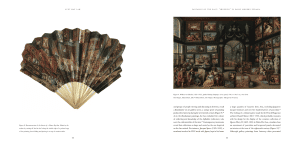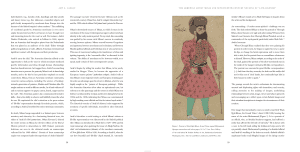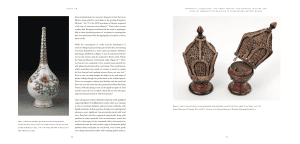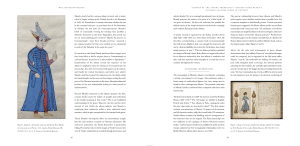Working to improve mutual understanding between the Middle East and the West
Working to improve mutual understanding between the Middle East and the West
No products in the basket.
This beautifully illustrated volume publishes a group of papers delivered at the third Gingko conference: ‘The Mercantile Effect: on Art and Exchange in the Islamicate World during 17th-18th Centuries.’ Held in Berlin in 2016, this meeting brought together a group of established and early-career scholars to discuss how the movement of Armenian, Indian, Chinese, Persian, Turkish and European merchants and their trade goods spread new ideas and new technologies across Western Asia in the early modern era. Operating through the newly-established Dutch, English and French East India companies, as well as much older mercantile networks, prestigious exotic commodities: silk, ivory, books and glazed porcelains were transported east and west. The collected essays in this volume introduce a fascinating array of subjects, all of them indicative of the impact of transcultural exchanges during the 17th and 18th centuries.
Sussan Babaie is Andrew W. Mellon Reader in the Arts of Iran and Islam, The Courtauld Institute of Art in London.
Melanie Gibson is Senior Editor of the Gingko Library Art Series.
Foreword by Melanie Gibson
Introduction by Sussan Babaie The Mercantile Effect: On Art and Exchange in the Islamicate World
Suet May Lam – Fantasies of the East: ‘Shopping’ in Early Modern Eurasia
Amy S. Landau – The Armenian Artist Minas and Seventeenth-Century Notions of ‘Life-Likeness’
William Kynan-Wilson – ‘Painted by the Turcks themselves’: Reading Peter Mundy’s Ottoman Costume Album in Context
Nicole Kançal-Ferrari – Golden Watches and Precious Textiles: Luxury Goods at the Crimean Khans’ Court and the Northern Black Sea Shore
Nancy Um – Aromatics, Stimulants, and their Vessels: The Material Culture and Rites of Merchant Interaction in Eighteenth-Century Mocha
Federica Gigante – Trading Islamic Artworks in Seventeenth-Century Italy: the Case of the Cospi Museum
Anna Ballian – From Genoa to Constantinople: The Silk Industry of Chios
Christos Merantzas – Ottoman Textiles Within an Ecclesiastical Context: Cultural Osmoses in Mainland Greece
Francesco Gusella – Behind the Practice of Partnership: Seventeenth-Century Portuguese Devotional Ivories of West India
Gül Kale – Visual and Embodied Memory of an Ottoman Architect: Travelling on Campaign, Pilgrimage and Trade Routes in the Middle East
Contributors
Foreword
In November 2016 the Gingko Library, in collaboration with the Courtauld Institute of Art and the Barenboim-Said Akademie, held its third annual conference entitled: The Mercantile Effect: Art and Exchange in the Islamicate World during the 17th ̶18th Centuries.
The essays gathered in this volume, which bears the same name as the conference, were first delivered in November 2016 at the Akademie in Berlin. The symbol of the Gingko Library, the distinctive bifurcated fan-shaped leaf of the gingko tree, is drawn from a poem, simply entitled ‘Gingo Biloba’, written by Johann Wolfgang von Goethe for his twelve-volume West-östlicher Divan (West-eastern Divan).1 He uses the leaf as a metaphor for friendship and intimacy and the Gingko Library has adopted it as a symbol of the academic collaboration and dialogue it promotes through annual conferences and a dynamic publishing programme.2
The opening poem in the West-östlicher Divan expresses Goethe’s passionate admiration for the ‘untroubled East’ in all its manifestations, not least its mercantile expertise. In the fourth verse he states his desire to:
Take my ease at oases when I wander with the caravans, deal in shawls, coffee, musk; I’ll tread every path from the deserts to the towns.3
Goethe chooses textiles, coffee, and perfume as typical examples of Middle Eastern merchandise. Little coincidence then that the first two of these products feature as topics in this volume of essays exploring the exchange of commodities in the early modern period.
Commerce around the Mediterranean and between Eastern and Western Asia, carrying raw materials and manufactured goods along land and sea routes, is well documented throughout the early Islamic centuries. The discovery of an Arab dhow shipwrecked off the Indonesian island of Belitung gives an indication of the volume of merchandise that was being shipped in the mid-ninth century: when the ship was raised it was found to be carrying some 60,000 ceramics along with gold and silver items that were no doubt intended as gifts to the Abbasid court in Baghdad.4 But the starting point for truly global mercantile exchanges, the moment when all kinds of goods produced on one side of the world could be swiftly transported and sold on the other, can be traced to the seventeenth and eighteenth centuries, with the active participation of European traders and the foundation of the Dutch, English and French East India companies to ship and transport merchandise as widely as possible.
I would like to thank my co-convenors: Barbara Schwepcke for her enthusiasm and generosity of spirit in founding and supporting Gingko and Sussan Babaie, whose academic engagement with mercantile networks gave us the theme of the conference, as well as all those who contributed papers, many of which are published in this volume.
Melanie Gibson




‘The Mercantile Effect captures unexpected glimpses of a vast and shifting landscape and brings them into focus; this is what the future of art history looks like.’
— George Manginis, Academic Director of Benaki Museum, Athens
‘This fine collection of stimulating essays is a fascinating introduction to some of commodities, tastes and ideas that flowed around the Middle East in the premodern era and proves once again how the study of small-scale artefacts and even everyday items powerfully adds to the larger story of trade and exchange.’
— Julia Gonnella, Director, Museum of Islamic Art, Doha
Our work relies on the generous support of our donors. Any contribution, no matter how small, helps us achieve our aims.